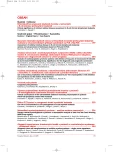Therapy-related myelodysplastic syndrome: a retrospective analysis of data from the Czech Working MDS Group registry
Authors:
P. Bělohlávková 1; R. Neuwirtová 2; J. Čermák 3; J. Vondráková 4; V. Vozobulová 5; M. Krejčí 6; N. Seifertová 7; M. Maturová 8; E. Kadlčková 9; A. Smolíková 10; E. Šumná 11; P. Kessler 12; E. Mandáková 13; E. Polonyová 14; J. Libiger 15; H. Krejčová 2; J. Mužík 16; J. Voglová 1; J. Malý 1
Authors‘ workplace:
II. interní klinika OKH FN a LF Hradec Králové, I. interní klinika VFN Praha, 3ÚHKT Praha
1; HOK FN Olomouc, 5HOO FN Plzeň , 6IHOK FN Brno, 7OKH České Budějovice, 8Oddělení klinické
hematologie a transfúziologie FN Bulovka, 9HTO Zlín, 10KlinLAB Praha, 11Hematologická ambulance
nemocnice Ostrava, 12OHT nemocnice Pelhřimov, 13Hemato-logická ambulan
4; Hematologické oddělení Karlovy Vary, 15OKH Ústí nad Labem, 16Institut biostatistiky a analýz MU Brno
14
Published in:
Transfuze Hematol. dnes,15, 2009, No. 4, p. 237-243.
Category:
Comprehensive Reports, Original Papers, Case Reports
Overview
The development of therapy-related myelodysplastic syndrome (t-MDS) occurs after exposure to cytotoxic agents and represents the serious long-term complication associated with current cancer therapy. The Czech MDS Study Group retrospectively analyzed these patients. In our registry we identified 111 patients (70 women, 41 men) with t-MDS. The median age was 68 years (32-86 years), median IPSS 1 (0-3) and median count of bone marrow blasts was 3% (0-33%). The distribution by WHO classification was following: 30% RCMD; 22% RAEB-2; 16% RAEB-1; 12% RA; 8% RCMD-RS; 5.5% RARS; 3.5% CMML and 3% MDS/MPS. The median time to development t-MDS after the primary exposure was 66.5 months (m) (2-384 m) with the median survival of 13 months (1-173 m). We observed these cytogenetic findings: in 13.5% abnormalities of chromosome 5; in 8% of chromosome 7; in 7% abnormalities of both chromosomes 5 and 7, 28% patients had normal karyotype; 8% complex changes and 7.5% the other changes. In 28% cases cytogenetic examination was not available. The most common primary malignancy was hematologic disease (25%). Of solid cancers t-MDS most frequently developed after breast (22%) and gynaecological (10.5%) carcinomas. The rapid progression to AML occurred in 36% patients. Overall survival of patients in our study correlated with WHO subtype, IPSS and number bone marrow blasts. However, we did not detect significant differences in the survival of patients according to cytogenetic changes, the type and treatment of primary malignancy.
Key words:
secondary myelodysplastic syndrome, therapy-related myelodysplastic syndrome
Sources
1. Pedersen-Bjergaard J, Andersen MT, Andersen MK. Genetic pathways in the pathogenesis of therapy-related myelodysplasia and acute myeloid leukemia. Hematology 2007; 392-397.
2. Larson RA. Etiology and management of therapy-related myeloid leukemia. Hematology 2007; 453-459.
3. Leone G, Pagano L, Ben-Yehuda D, Voso MT. Therapy-related leukemia and myelodysplasia: susceptibility and incidence. Haematologica 2007; 92 : 1389-1398.
4. Rowley JD, Golomb HM, Vardiman JM. Nonrandom chromosome abnormalities in acute leukemia and dysmyelopoietic syndromes in patients with previously treated malignant disease. Blood 1981; 58 : 759-767.
5. Pedersen-Bjergaard J. Therapy related myelodysplasia. Leukemia Research 2007; 31: S1-S3.
6. Smith SM, Le Beau MM, Huo D, et al. Clinical-cytogenetic associations in 306 patients with therapy-related myelodysplasia and myeloid leukemia: the University of Chicago series. Blood 2003; 102 : 43-52.
7. Mauritzson N, Albin M, Rylander L, et al. Pooled analysis of clinical and cytogenetic features in treatment-related and de novo adult acute myeloid leukemia and melodysplastic syndrome based on a consecutive series of 761 patients analysed 1976-1993 and on 5098 unselected cases reported in the literature 1974-2001. Leukemia 2002; 16 : 2366-2378.
8. Howard RA, Gilbert ES, Chen EB. Leukemia following breast cancer: an international population-based study of 376 825 women. Breast Cancer Res Treat 2007; 105 : 359-368.
9. Travis LB, anderson M, Gospodarowicz M. Treatment-Associated Leukemia Following Testicular Cancor. J Natl Cancer Inst 2000; 92 : 1165-1171.
10. Kűndgen AK, Haase D, Giagounidis A, et al. Clinical and prognostic characteristics of 484 patients with therapy-related myelodysplastic syndrome or acute myeloid leukemia. Haematologica 2008; 93 : 284 Abstr. 0708.
11. Abdelhameed A, Pond GR, Mitsakakis N, et al. Outcome of patients who developed acute leukemia or myelodysplasia as a second malignancy after solid tumors treated surgically or with strategy that include chemotherapy and/or radiation. Cancer 2008; 112; 1513-1521.
12. Singh ZN, Dezheng H, Anastasi J, et al. Therapy-related myelodysplastic syndrome. Morphologic subclasisification may not be clinically relevant. Am J Clin Pathol 2007; 127 : 197-205.
13. Estey EH. Prognosis and therapy of secondary myelodysplastic syndromes. Haematologica 1998; 83; 543-549.
14. Takeyama K, Seto M, Uike N, et al. Therapy-related and myelodysplastic syndrome: a large-scale Japanese study of clinical and cytogenetic features as well as prognostic factors. Int J Hematol 2000; 71 : 144-152.
15. Kröger N, Brand R, Brezen A, et al. Risk factors for therapy-related myelodysplastic syndrome and acute myeloid leukemia treated with allogeneic stem cell transplantation. Haematologica 2009; 94 : 542-549.
Labels
Haematology Internal medicine Clinical oncologyArticle was published in
Transfusion and Haematology Today

2009 Issue 4
Most read in this issue
- Congenital polycythemias
- The role of FLT3 mutations in the pathogenesis of acute myeloid leukemia
- Assessment of minimal residual disease in B-cell chronic lymphocytic leukemia: options and advancement of techniques based on PCR and RT-PCR
- Therapy-related myelodysplastic syndrome: a retrospective analysis of data from the Czech Working MDS Group registry
